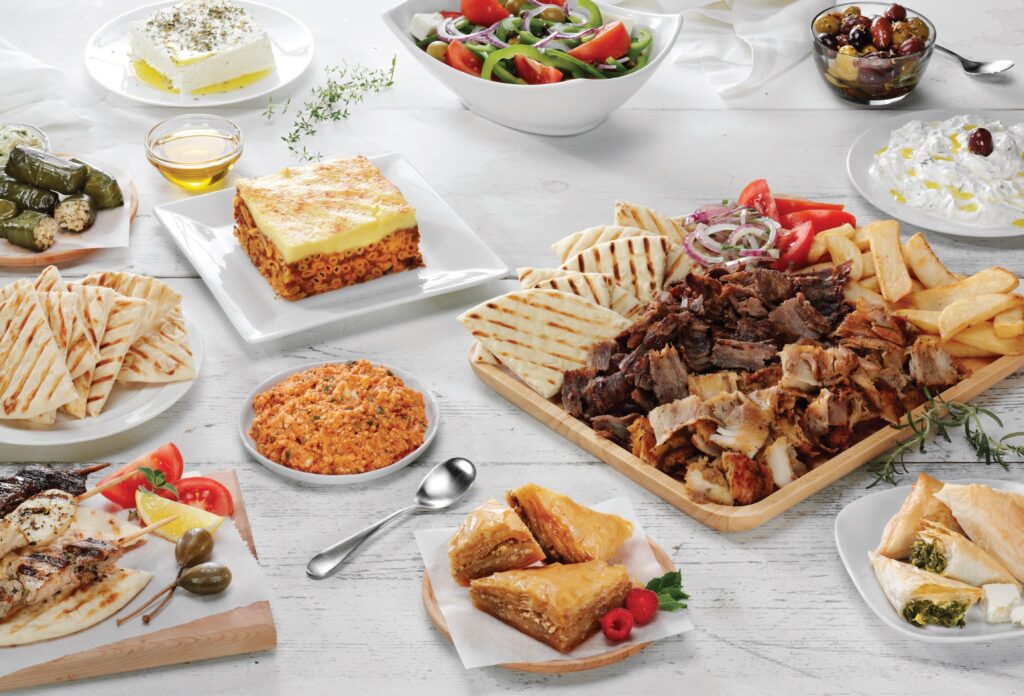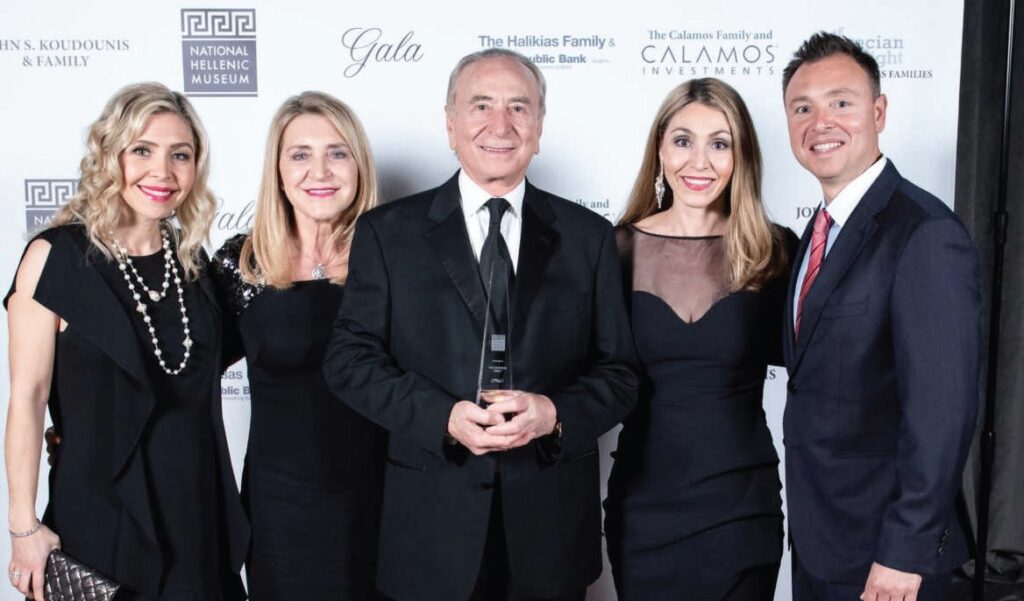A Specialty Food Legend’s 50-Year Odyssey
Posted by estiator at 18 January, at 06 : 11 AM Print
COVER STORY
Grecian Delight / Kronos is just getting started.
By Constantine N. Kolitsas
It’s not often that a company that’s been around for five decades has the same energy, drive, and ambition as start-up, but that’s exactly what you find when you sit-down with Peter Parthenis, Jr., the CEO and president of Grecian Delight/Kronos (Grecian Delight and Kronos merged in 2021). Since 2007, Parthenis has been at the helm of the company his father created in 1974 (and now the merged company), having overseen its expansion into international markets, and the growth of its product portfolio into new expressions of Mediterranean cuisine.

“It’s an exciting time to be in this particular specialty food space,” says Parthenis, indicating that the market for Mediterranean restaurants in the United States is currently at a whopping $44 billion. “Over the last four years, the menu penetration of Mediterranean cuisine has grown by 25 percent,” he adds, “and we’ve seen that growth accelerate year after year.”
To witness that growth, you don’t have to go much further than looking at the company’s last 50 years. Parthenis isn’t boasting when he says that Grecian Delight and Kronos changed America’s menus; he’s stating fact. Those companies, along with the other gyro/Mediterranean food giants formed in Chicago around the same time, educated Americans in Mediterranean cuisine and developed their palates, particularly in Greek flavors.
Together with the Greek-owned restaurants and church festivals, these two companies created the market, with gyro leading the charge. Indeed, the early story of these companies is the story of gyro and how the American public became enamored of the Greek street-food staple.
“I’ve been eating gyro for more than 40 years,” says Greg Fernand, a customer at a Connecticut-based Greek restaurant. Irish by background, Greg says he was introduced to it by a friend who brought him along to his church’s Greek festival over four decades ago. He’d wait every year for the festival sign to go up and eat six or seven of them over the course of the festival’s three days. That would be his fix for the year, as no restaurants in the area would put them on menus for at least another decade. Now, he says, he gets that fix on a weekly basis but still goes to that same festival every year out of nostalgia.
Greg, of course, is not unique, but, rather, indicative of much of the American public, which discovered gyro early on and, from there, learned about and came to love Greek and Mediterranean cuisine. In many ways, gyro was the gateway “drug” that hooked Americans on other elements of the cuisine. Spanakopita, hummus, tzatziki, tyropita, and baklava followed quickly in popularity.

To create a market for his machines, he embarked on a strategic journey to expand the reach of gyro across Chicago, presenting it at the first food shows at McCormick Place, “a pivotal move that opened the doors to wider recognition,” he says.

“The restaurateurs took the risks of investing in the cuisine at a time when it was unknown,”says Parthenis, acknowledging the important role that the wide network of Greek restaurant owners played in the development of their native food in the United States.
“By supplying those restaurants with gyro cones and pitas early on, and eventually many more products, we were able to change America’s menus,” he adds. And if the saying is true, that the way to a person’s heart is through their stomach, Parthenis is onto something when he says his company helped develop appreciation for not only Greek food but Greek culture, “one serving at a time.”
The Beginning
The story of Grecian Delight begins with its founder, Peter Parthenis, Sr. Born in Vonitsa, a small coastal village on Greece’s western shores. Parthenis grew up in an impoverished post-WWII Greece. The death of his father from appendicitis when he was just 40 days old thrust his family into hardship as his mother was left to raise him and his two sisters on her own.
“We grew up in a house that was less than 500 square feet with no electricity or running water, ”he says, indicating that they relied on runoff water from the local power company for warm baths. “Things were so tough that my mother would become anxious every time I went for a swim, concerned that I would come home too hungry.”
As a young man, Parthenis showed no interest in sports but, rather, spent his time tinkering with bicycles at a local repair shop where he worked as a teenager, a passion that would manifest in a few short years when he left Greece to pursue an engineering degree in the States.
With a pair of suitcases and $300 in his pocket, Peter made his way to Chicago, enrolling at the University of Illinois Chicago while taking jobs at local Greek-owned restaurants.
Along with a passion for engineering, Parthenis brought with him an entrepreneurial spirit, inspired by the American movies he saw growing up. Upon completion of his degree in engineering and automation in 1971, he began working on business opportunities in pioneering areas, some of which could return him to Greece. He eventually abandoned those initiatives, as well as plans to design automatic carwashes that he would also bring to Greece, he says, due to the instability of the Greek political regime of the time. Fortunately, another opportunity presented itself.
Because of his engineering skills, Chicago restaurateurs began to solicit him to repair the vertical rotisseries they were importing from Europe. A light bulb went off, and Optimal Automatics was created to design and build machines that would be used to cook gyro.
To create a market for his machines, he embarked on a strategic journey to expand the reach of gyro across Chicago, presenting it at the first food shows at McCormick Place, “a pivotal move that opened the doors to wider recognition,” he says.
Soon thereafter, the Chicago Hilton put gyro on their menu and a ripple effect spread across the Windy City. It was not long before Parthenis had a “Microsoft moment.” Just as Bill Gates would recognize that the money was not in the hardware but in the software for his industry, Parthenis realized that the money for gyro was not in the machines but in the meat itself. Chicagoans in the know devoured gyro to the point that the restaurant owners serving it struggled to secure reliable supplies of meat. Parthenis met this challenge by evolving his business model to produce gyro himself, founding Gyros, Inc., in1974. As its popularity grew, those restaurants couldn’t keep up with production in their small mom-and-pop eateries and gladly outsourced the work to Parthenis.
“What began as a small venture to promote my father’s Greek heritage and love for the food industry soon grew into a revolution,” says Peter Jr.


The introduction in 2017 of “Ready Carved,” fully cooked gyro sliced directly off the cone was another defining moment of Peter Jr.’s administration.
Gyro Is Just the Beginning
Considered a “poor man’s food” in Greece at the time, gyro grew in popularity within a short time of its introduction in Chicago. With a similar passion, entrepreneur Chris Tomaras entered the scene a year after Parthenis created Gyros Inc. His company, Kronos, was established in 1975 and, along with Parthenis’s company, forged a path for Greek cuisine that spread from the American Midwest to all parts of the country.
Parthenis, ever the resourceful problem-solver, reminisces about the challenges of fulfilling demand beyond Chicago in those early days. “We didn’t have a distribution deal at the time, “he says,” so the first gyros ever shipped out of Chicago were packed onto a Grey-hound bus, headed for Atlanta. They were carefully frozen and encased in double corrugated boxes, mingling with the luggage of fellow travelers.
“Shortly after introducing gyro to a broader market, in 1975 Parthenis began adding other Greek items to his company’s range of products, beginning with tzatziki, a critical component of the gyro experience. Two years later, the company was producing baklava, moussaka, and pastitsio, evidence of Parthenis’s passion to promote the best of Greek cuisine.
And it wasn’t just its list of product offerings that grew; by 1981 Grecian Delight had outgrown its quarters in Skokie, Illinois, and expanded to a 40,000-square-foot facility in Chicago. A year later, they added an additional 30,000 square feet to produce pita bread. By 1993, they had outgrown that facility as well, constructing a manufacturing facility in Elk Grove Village that offered 170,000 square feet of production space.
By the end of the decade, Peter Jr. began working at Grecian Delight and, after immersing himself in its operations and manufacturing capabilities and leading its sales and marketing efforts, assumed his father’s role of President and Chief Executive Officer in 2007. This generational change and Peter Jr.’s vision was to continue the company’s growth. Utilizing the company’s assets and broad product capabilities led to an expansion of its portfolio products, which came to encompass a broader Mediterranean cuisine focus with products that include chicken shawarma and porkal pastor, specialty flatbreads like naan and lavash, and hummus and falafel. And as consumers began to seek out foods that were minimally processed, Peter Jr. led the charge to invest in innovation and expansion that placed a strong focus on healthier, clean label products.
Following his father’s pioneering spirit, Peter Jr. innovated by developing new markets through national foodservice chains and brought Grecian Delight into the retail sector with the Opaa! line of products (gyro kits, sauces, shawarma, etc).
The introduction in 2017 of “Ready Carved, ”fully cooked gyro sliced directly off the cone was another defining moment of Peter Jr.’s administration. The revolutionary technology allowed more restaurants to serve high-quality gyro without the use of a rotisserie. Portion control, quality assurance, and a less labor-intensive process are attributes of the product, an indication of the company’s ability to address the needs of its restaurant customers. A year after developing the product line, Grecian Delight introduced it to the retail market in consumer-friendly packages.
On the business side, in 2020 Peter Jr. led the acquisition efforts with longtime rival Kronos Food Corp and executed an integration plan to merge the two companies, realizing an aspiration held for decades by his father. Three years in, Peter Jr., at the helm of the Grecian Delight/Kronos organization, confides that the merger has been a bona fide success.
“We navigated the process through the epidemic,” he says, “and have come out of it stronger than ever.”
From the onset, it was determined that both the Grecian Delight and Kronos brands would-be preserved rather than consolidating both entities into one. “Both brands have high brand trust and very loyal customers,” he says, “and over 500,000 square feet of manufacturing space.”
It’s a good thing, he adds, because they need all the production capability those facilities provide just to meet demand.
“We found that the time, energy, and resources the two companies spent competing against each other is now put to use building markets, innovating, and bringing solutions to our customers—activities that have expanded the business. Instead of fighting each other for market share, we’re focusing our efforts to bring our offerings to a public that is increasing its demand for Greek and Mediterranean foods.”
In most cases, he says, the two companies were sold through different distributors. Now that they’ve merged into one, its distribution channels encompass both sets of networks, meaning that Grecian Delight’s portfolio has a broader reach since the merger, as does Kronos’s line of offerings.
“In addition to being a one-stop shop,” he says, “we now have the ability to offer more convenience and products to customers, including plant-based foods and more ready-to-eat proteins, while also engaging and fulfilling demand for new markets beyond North America.”
Of course, there is incredible opportunity for the company as Mediterranean and Greek cuisine continues to grow in popularity here in North America.
Today, the company’s products are sold in 10 countries around the globe, says Peter Jr., the first steps in his plans to bring them to a global consumer base. Over 400 foodservice distributors provide his company’s products to more than 30,000 independent restaurants and national chains, while its retail products can be found in the top 40 retailers across the U.S.
“The next 10 years,” Parthenis says, “will be about meeting global demand. We are working to position ourselves to successfully meet the demand for Greek and Mediterranean foods.”
Of course, there is incredible opportunity for the company as Mediterranean and Greek cuisine continues to grow in popularity herein North America. According to industry analysts, two thirds of restaurant guests tried global foods (beyond Italian, Mexican, and Chinese) in the last month, led by the eating habits Gens Y and Z (on one end of the spectrum, 19 percent of Baby Boomers ate globally within the past week compared with 58percent of Gen Zers). And then there are demographic trends. Among Gen Alpha (individuals born since 2013), ethnic populations make up51 percent, a sign that ethnic food trends will continue to grow.
At Grecian Delight/Kronos, Peter Sr. maintains a presence at the company he birthed five decades ago, observing, motivating, and spreading his passion to its workforce.
“We just had our annual holiday party,” says Peter Jr. “I can remember when it was 50 or 60people. This year we had more than 650.” The company’s success, he says, is their success. “The dream could not have happened without them.”
















